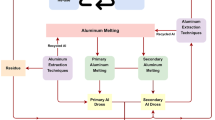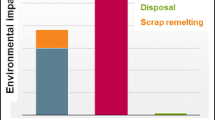Abstract
In this study bronze mirrors from the Zonglvcheng cemetery in Linzi city, the unique bronze mirror production centre of the Western Han dynasty (WHD, 202 BCE-8 CE), were subjected to scientific examinations. Compositional and lead isotope ratio analyses on 41 bronze mirrors from different periods of WHD were conducted. For the first time, a mirror made of pure lead and another one made with highly radiogenic lead were identified. The compositional analysis revealed a roughly stable copper-tin-lead ratio of 14:5:1 for mirrors, providing insights into the standardised mirror production. The interpretation of isotope ratios was done by combining characteristic parameters and kernel density estimate methods, compiling a wide range of published data for comparison to mitigate the detrimental effects of the overlap effect. The results indicate that the majority of mirrors were produced within Linzi city, but their lead sources were likely from the Xiaoqinling metallogenic belt controlled by the Han Empire rather than local to Shandong province. This study demonstrates that changes in the alloy compositions and ore sources for bronze mirrors and other objects with time were influenced by state-intervention economic policies, providing a new perspective for the study of technical and economic history during the WHD.








Similar content being viewed by others
Data availability
No datasets were generated or analysed during the current study.
References
Albarede F, Desaulty AM, Blichert-toft J (2012) A geological perspective on the use of pb isotopes in archaeometry. Archaeometry 5:853–867
Bai Y (2010a) Discovery and identification of Han-style bronze mirrors in central Asia. Cult Relics 1:78–86
Bai Y (2010b) On the two traditions of the bronze mirror casting techniques in east Asia. Archaeology 2:63–77
Bai Y, Zhang G (2005) Discovery and study of the Han period mirror molds from the site of the Qi state capital Linzi, Shandong. Archaeology 12:68–83
Belmonte JA, González-García AC (2014) On the orientation of early bronze age tombs in ancient Magan. Mediterranean Archaeol Archaeometry 14:233–246
Chen Q (2010) The salt and iron conference and the evolution of state intervention in the economy during the Western Han dynasty. Thesis, Yunnan University
Chen D, Luo W, Zeng Q et al (2018) The lead ores circulation in central China during the early western Han dynasty: a case study with bronze vessels from the Gejiagou site. PLoS ONE 11:e205866
Chen D, Luo W, Bai Y (2019) The social interaction between China and Japanese archipelago during western Han dynasty: comparative study of bronze mirrors from Linzi and Yayoi sites. Archaeol Anthropol Sci 7:3449–3457
Cheng L, Han G (2002) Mirrors of Han dynasty found in Chang’an. Shaanxi people’s publishing house, Xi’an, China
Cui J, Wu X, Bai Y et al (2009) An analysis of the lead isotope ratios of the western Han bronze mirrors from the Linzi city-site of the Qi state in Shandong. Archaeology 4:85–89
Cui C, Li Y, Dai Q (2021) Analysis of the source of raw materials for bronze artifacts and slag found on the Shandong Peninsula. Cult Relics South China 3:184–190
Dong Y (2000) A study on the relation between the alloy ingredients of ancient mirrors and the difference of the sectional geometrical forms of the mirror bodies. J Natl Museum Chin History 2:114–121
Du N, Wang X, Li J et al (2012) Investigation and research on copper slag from the encircling wall of the ancient city of qi in Linzi, Shandong. J Jiangxi Univ Sci Technol 2:14–17
Gao J (2022) Metal resource circulation and diffusion of metallurgy in prehistoric oasis society of Gansu and Xinjiang-focus on scientific analysis on metal objects from Hami basin. Dissertation, University of Science and Technology of China
Gao J, Fan A, Li G et al (2021) An electrodeposition device for lead in ancient copper alloys. CN21510308U
Hsu Y, Sabatini BJ (2019) A geochemical characterization of lead ores in China: an isotope database for provenancing archaeological materials. PLoS ONE 4:e215973
Institute of Archaeology, Chinese Academy of Social Sciences (IACASS) (2020) Shandong Provincial Institute of Cultural Relics, Research Center for Qi Culture Development of Linzi District. Archaeology of metallurgy and foundry industry in the Linzi city site of Qi State. Science, Beijing, Zibo City
Institute of Isotope Geology, Yichang Institute of Geology and Mineral Resources Ministry of Land and resources, China (IIGYIGMRMLRC) (1979) fundamental issues in lead isotope geological research. Geological Publishing House, Beijing
Jin Z (2008) Lead isotope archaeology in China. University of Science and Technology of China, Hefei, China
Jin Z, Liu R, Rawson J et al (2017) Revisiting lead isotope data in Shang and Western Zhou bronzes. Antiquity 360:1574–1587
Juliano A (1985) Possible origins of the Chinese mirror. Source: Notes History Art 4(2/3):36–45
Killick DJ, Stephens JA, Fenn TR (2020) Geological constraints on the use of lead isotopes for provenance in archaeometallurgy. Archaeometry S2:86–105
Li Y, Du N, Li J (2014) An investigation and study of copper smelting remains at the SFT site in the ancient city of Qi, Linzi, Shandong. Huaxia Archaeol 01:3–10
Lin Y, Luo S (2023) Analysis of Han dynasty copper artifacts in southern Jingzhou (Chenzhou region) and related issues in Han dynasty copper industry. Cult Relics South China 03:134–146
Liu G (2010) Brief comment on Sang Hongyang’s law of conveying equalization equally. J Changchun Inst Technol (Social Sci Edition) 3:19–21
Liu Y, Zhao Z, Bai Y et al (2005) Analysis of the Han period mirror-mold from the Qi state capital Linzi in Shandong. Archaeology 12:84–89
Luo Z, Jin Z, Zhao Z et al (2023) Lead isotope reveals the mineral source change of late bronze age bronze mirrors excavated in Hunan province, southern China. J Archaeol Science: Rep : 103994
Mabuchi H (1992) Provenance studies on bronzes according to lead isotope ratios. In: The application of modern natural scientific technology in archaeology—proceedings of the third Japanese Universities and Science conference. Northwestern University Press, Xi’an
Mabuchi H (2011) Studies on some chemical aspects of Chinese Han-style mirrors: transition of lead isotope patterns from ‘Western-Han mirror type’ to ‘Eastern-Han mirror type’. Archaeol and 62:43–63
Mabuchi H, Hirao Y (1982) Study of Han style mirrors by lead isotope method. Museum 370:4–12
Mabuchi H, Hirao Y, Nishida M (1985) Lead isotope approach to the understanding of early Japanese bronze culture. Archaeometry 27:131–159
Nara Prefecture of Japan (AIKNPJ) (2007) Archaeological Institute of Kashihara. Archaeological study of the Han period mirror-molds from the site of the Qi state capital Linzi in Shandong Province, China. Science, Beijing
Sun S, Qian W (2000) An overview of the use and mechanical properties of ancient copper, arsenic copper, and bronze. History Mech Technol 0:237–245
Yang Y (2023) Han dynasty artifacts unearthed in southeast Asia and the maritime silk road during the Han dynasty. Sichuan Antiquities 04:75–87
Yang Y, Bai Y (2020) Mirror molds in the ancient city of Linzi and Han dynasty mirror casting technology. Cult Relics Cent China 1:102–115
Yang D, Wu X, Liu R et al (2023) From diversity to monopoly: major economic policy change in the western Han dynasty revealed by lead isotopic analysis. Archaeol Anthropol Sci 3
Zhang Y, Zhang X, Guo W et al (1982) The tomb of short bronze sword in Xihuangshan, Huadian, Jilin Province. Archaeol History Northeast China 1:141–152
Zhangsun YZ, Liu RL, Jin ZY (2017) Lead isotope analyses revealed the key role of Chang’an in the mirror production and distribution network during the Han. Archaeometry 4:568–713
Acknowledgements
The authors have benefitted greatly from insightful comments from the editor and reviewer(s). The authors would like to thank Xintian Zhang for his assistance in sample collection and all the members who participated in the excavation of Zonglvcheng. We also thank Dr Xingxiang Zhang, Xiansheng Yan and other lab members for their assistance in the experiments on lead isotopes.
Funding
The research was supported by the Natural Science Foundation of Shandong Province (ZR2023QE207) and Conservation and Research on Metal Objects from Linqiancun cemetery, Qufu, Shandong Province (SK230335).
Author information
Authors and Affiliations
Contributions
J Gao: conceptualization, methodology, formal analysis, investigation, data curation, writing—original draft, visualization, project administration, funding acquisition.W. B. Dong: resources, sample providing, writing—original draft.X. Wu: sample providing, review and editing. X. Wang: data curation, review and editingF. Huang: data quality monitor.Q. Wang: conceptualization, methodology, formal analysis, resources, data quality monitor, project administration, funding acquisition, writing—review and editing.
Corresponding author
Ethics declarations
Competing interests
The authors declare no competing interests.
The authors declare no competing interests.
Ethics approval
Not applicable.
Consent to participate
Written informed consent was obtained from all the participants prior to the enrolment of this study.
Consent for publication
Written informed consent was obtained from all the participants prior to the publication of this study.
Conflict of interest
The authors declare no competing interests.
Additional information
Publisher’s Note
Springer Nature remains neutral with regard to jurisdictional claims in published maps and institutional affiliations.
Electronic supplementary material
Below is the link to the electronic supplementary material.
Rights and permissions
Springer Nature or its licensor (e.g. a society or other partner) holds exclusive rights to this article under a publishing agreement with the author(s) or other rightsholder(s); author self-archiving of the accepted manuscript version of this article is solely governed by the terms of such publishing agreement and applicable law.
About this article
Cite this article
Gao, J., Dong, W., Wu, X. et al. Technical and economic history of western Han dynasty revealed by bronze mirrors from Zonglvcheng cemetery, Linzi, China. Archaeol Anthropol Sci 16, 73 (2024). https://doi.org/10.1007/s12520-024-01977-8
Received:
Accepted:
Published:
DOI: https://doi.org/10.1007/s12520-024-01977-8




